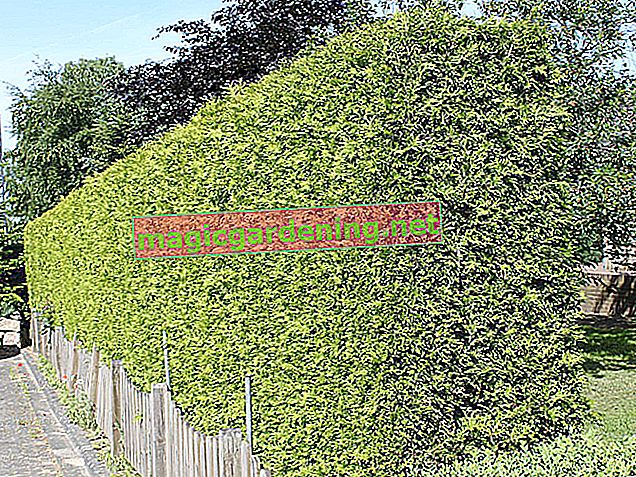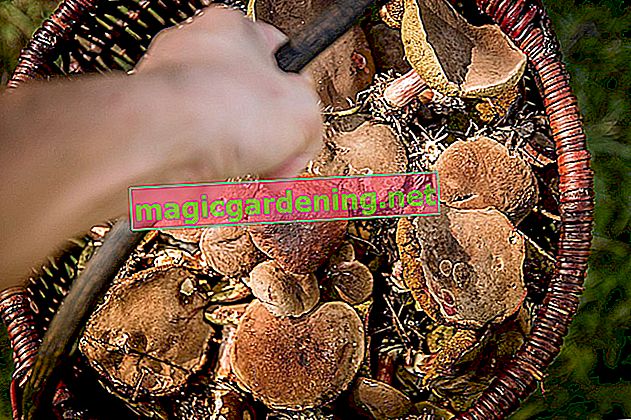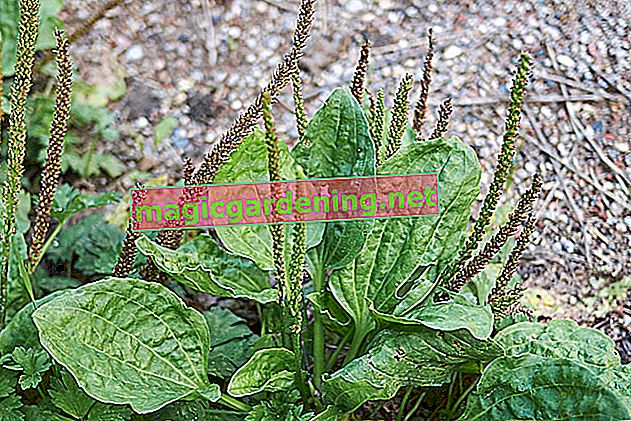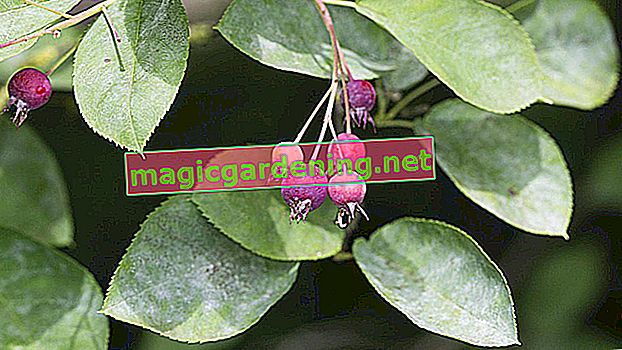
Origin and Distribution
The butterfly lilac belongs to the fig family (Scrophlariacae) and includes around 100 different species. These are common in the tropical and subtropical areas of the two American continents as well as Asia and Africa, where they mainly occur in dry, warm and sunny locations. Not all species are used as ornamental plants, especially since most of the summer lavender in this country is not hardy at all. Incidentally, the Buddleja species are not related to the common lilac, despite their resemblance. From a botanical point of view, this belongs to the olive family (Oleaceae).
also read
- This is how you care for a butterfly lilac in an exemplary manner
- How to properly transplant a butterfly lilac
- Planting butterfly lilacs - how to do it at the optimal time
use
Particularly popular for the home garden is the robust and sufficiently hardy species Buddleja davidii, which also has the greatest variety of all butterfly lilacs. The alternate or Chinese butterfly lilac (Buddleja alternifolia) is also used in borders and in the front garden, whereas the distinctive yellow buddleia (Buddleja x weyeriana) is not frost-hardy and is therefore only allowed outside in mild winter regions. However, all of the above mentioned butterfly lilacs are ideally suited for a pot culture, provided the variety is not too vigorous.
The butterfly lilac cuts a fine figure both in colorful herbaceous borders, in a bed with colorful summer flowers, along dry embankments and as a solitary in the front garden. Vigorous varieties with heights of up to three meters and widths of up to two meters can also be used wonderfully for planting hedges and for delimiting properties and garden areas.
Plant the shrub together with annual flowers, perennials such as sedum or asters, bulb flowers or herbs such as sage, lavender or thyme. It is not only important that the colors harmonize with each other when arranging the plants for the borders, but that the different species have the same needs in terms of location and care.
Appearance and stature
Especially Buddleja davidii is very suitable for the Central European climate with its sometimes cold and severe winters. The species also scores with numerous cultivated forms in different heights and flower colors. Butterfly lilacs usually grow funnel-shaped and wide upright up to three meters in height, with some varieties having a rather compact growth and only up to one and a half meters high. The panicle-like flowers are at the end of the side shoots, which often tilt due to their weight.
The shoots of Buddleja davidii often freeze back in cold winters, but this is usually not a problem. If the root network remains undamaged, the shrub sprouts again in spring and, due to its very rapid growth, quickly reaches the height of the previous year. The species is evergreen, ie the green-gray leaves usually remain on the branches until the first frost and only then die.
Blossoms and flowering period
Most species and varieties of the butterfly lilac do not show their lush blossoms until July, but then - at least with appropriate care - until well into autumn. The long flower panicles are so heavy that the branches bend under their weight. They also smell more or less strongly depending on the variety, and the choice of flower colors is very large. The panicles bloom in different white, pink, red or purple tones, only yellow colors are reserved for the not hardy yellow butterfly lilac.
In order to be able to enjoy the flowering period as long as possible, you should cut off dead shoots as soon as possible. This also prevents the formation of capsule fruits, which often contain numerous seeds. If you don't pay attention, you will be happy to sow them yourself and you will have to remove young butterfly lilacs from the whole garden in the following year.
Toxicity
Even if the most varied of moths love to feast on the sweet nectar of the butterfly lilac, unfortunately all parts of the plant are poisonous for humans and pets. The leaves and seeds in particular contain toxic substances, including saponins and glycosides such as catapol and aucubin. Therefore, never feed the clippings to your pets, not even cattle or horses, and make sure that small children do not nibble on the leaves or flowers. If symptoms of poisoning occur, such as headaches, nausea, cramps, diarrhea and / or vomiting (it does not have to occur all at once!), Please consult a doctor or veterinarian immediately.
However, healthy parts of plants can be composted without hesitation.
Which location is suitable?
Since the butterfly lilac comes from warm and sun-drenched countries, it also feels particularly comfortable in the garden in such a location. The summer lilac is very comfortable in a hot location that is in full sun around noon, which is why you can plant it on a bright south-facing wall. Place the shrub in full sun and sheltered, although a location in light partial shade is sufficient if necessary. However, it is then important that the Buddleja receives a few hours of direct sun in the morning and in the evening. But if it is too shady, the butterfly lilac stops growing and does not develop any flowers.
Continue reading
Substrate / soil
The ideal soil for the butterfly lilac is well-drained, loose and only moderately rich in nutrients. The shrub likes to stand in a poor and gravelly substrate. On the other hand, the plant does not tolerate loamy, heavy or wet soils, which is why you should improve the soil when planting on the one hand by adding compost and gravel / sand if necessary and on the other hand ensure drainage. In this way waterlogging cannot arise in the first place.
Pot culture
Frost-sensitive species of butterfly lilac, such as Buddleja globosa or Buddleja x weyeriana, should be cultivated in large containers and not planted in garden berries. Smaller versions of Buddleja davidii and other hardy butterfly lilac species can also be cultivated very well in plant containers, as long as the container selected for them is large enough and offers plenty of space for the roots.
The so-called dwarf butterfly lilacs such as 'Summer Lounge' or 'Purple Emperor' are particularly suitable for this. They reach heights of up to 150 centimeters and therefore also fit on narrow balconies. However, the following applies to all butterfly lilacs: Choose a large, wide and deep planter made of ceramic or clay. This offers the roots plenty of space and at the same time prevents the inside from heating up through possible evaporation. Because the butterfly lilac likes sun and warmth, but thrives best with roots that are kept cool.
Fill potting soil mixed with gravel and expanded clay (€ 17.50 at Amazon *) into the plant according to which you should of course not forget the pot drainage: The drain hole at the bottom of the pot is mandatory so that excess water can drain off. The butterfly lilac has to be fertilized and watered regularly so that it neither dries out nor stands permanently with the roots in the wet. Between April and August you also provide the shrub with a liquid container plant fertilizer, which you only need to use lightly. The nutritional requirement of the butterfly lilac is only small. During the winter months there is only little watering, little fertilization and the plant is also overwintered frost-free in a cool and bright room if possible.
Plant butterfly lilacs properly
Butterfly lilac is often pulled and offered in containers. When planting these specimens, make sure not to plant them deeper in the garden than they were before in the pot. If necessary, mark the relevant point with a pen.
Proceed as follows when planting Buddleja:
- Lift the plant out of the container, shake off the soil.
- Now place it with the root ball in a bucket filled with water.
- Let them soak in the moisture.
- In the meantime, dig a planting hole.
- This should be twice as deep and wide as the root ball.
- Put a five centimeter thick drainage layer in the bottom of the planting hole, e.g. B. with coarse gravel.
- Mix the excavated material with plenty of compost and possibly gravel / sand.
- Plant the butterfly lilac. Carefully step on the earth.
- Thoroughly sludge the root area.
To prevent premature drying out due to evaporation, especially in hot and dry times, you can cover the area of the roots with bark mulch or another material.
Continue reading
What is the best time to plant?
All species and varieties of butterfly lilac should only be planted in the garden after the ice saints in May. It is ideal when the soil is already warmed up a bit and no more night frosts occur. Now the shrub can grow safely until the first frost.
The correct planting distance
Especially the varieties of the species Buddleja davidii can take up a lot of space with a height of around three meters and a width of up to two meters - especially since the bushes also grow very quickly and a plant spacing that is too narrow can quickly become a problem. Solitary trees should be planted at a distance of at least 150 centimeters, for hedges and groups, however, between 80 and 100 centimeters are sufficient, depending on the variety. The dwarf variants require significantly less space for themselves.
Underplants
Since the butterfly lilac often remains bare in the lower area, you can plant it under with annual summer flowers, bulb flowers or low-growing perennials.
How do I transplant properly?
In May or June, if necessary also in early autumn, the butterfly lilac can usually be moved to a new location without any problems. You should only refrain from transplanting in the middle of summer, because the inevitable loss of roots can quickly cause the shrub to suffer from a lack of water. Incidentally, this is also the reason why plants to be moved always have to be cut back. And that's how it works:
- Cut back the butterfly lilac by about a third.
- Tie the shoots in the upper area with a ribbon or something similar.
- Be careful not to crush or injure the branches.
- Use a sharp spade to dig a trench around the shrub.
- Cut through longer roots.
- Loosen the root ball with the help of a digging fork.
- Carefully lift out the whole plant.
- Put them back in a new location.
- Give it plenty of water to make it easier for it to grow.
- More watering is also important in the weeks after repositioning.
By the way, you should also mix the excavated plant hole with plenty of compost.
Continue reading
Water the butterfly lilac
Even if freshly planted butterfly lilacs have to be watered well every now and then so that they grow better and do not get into drought stress until then, specimens already established in their location very rarely need water from the garden hose or watering can. You can only water it if it is warm and dry for a longer period of time and / or the shrub shows signs of this. Buddleja kept in buckets, on the other hand, are dependent on a regular supply of the precious liquid, as they are not able to do so themselves. However, avoid waterlogging in any case, as this inevitably leads to root rot.
Since the butterfly lilac is very lime-tolerant, you can pour it with tap water without hesitation.
Fertilize butterfly lilacs properly
Not only in terms of water, but also in terms of nutrient supply, the butterfly lilac is quite undemanding. Provide planted bushes with plenty of compost and a handful of horn shavings (€ 6.39 at Amazon *) to stimulate the subsequent new growth when planting and always after pruning. If the Buddleja doesn't want to get into a blooming mood, a nutrient deficiency can be the cause. Eliminate this with a liquid universal fertilizer or with the more frequent supply of compost or manure. Only butterfly lilacs kept in planters must be given a liquid fertilizer for potted plants every two weeks together with the irrigation water.
Continue reading
Cut butterfly lilacs correctly
Possible pruning measures always depend on the species and variety of the butterfly lilac. Buddleja davidii, for example, only develops flowers on the new shoots and should therefore be cut back drastically in spring: the gardener calls this “put on the cane”. In doing so, cap all parts of the plant to a height of 20 to 30 centimeters above the ground, although this measure should be necessary after most winters anyway: The species often freezes back in frosty temperatures. If possible, do this pruning in March, but no later than April.
Other species of butterfly lilac, however, such as the Chinese Buddleja alternifolia, must not be pruned as much. You only thin out these species after flowering by cutting off branches that are too close together and dry. However, be careful not to cut any new shoots, as the species will bloom on these in the coming year.
Regardless of the type of butterfly lilac, you should always cut back withered shoots. In this way, the shrub does not invest its energy in the formation of fruits and seeds, but instead sets new flowers.
Continue reading
Propagate butterfly lilacs
If you particularly like a certain butterfly lilac, you should always propagate it using cuttings. This is the only way that the offspring are genuinely pure and have the same properties as the mother plant - after all, it is basically a genetically identical clone. You can achieve the same effect if you plant sinkers instead of cuttings or cut cuttings from the clippings. The vegetative type of propagation works in the butterfly lilac without any problems according to this scheme:
- The best times to cut the cuttings are June and July.
- Choose young, semi-lignified twigs with no blossoming flowers for this purpose.
- Wholly lignified branches are not suitable for cutting, but for cuttings.
- Cuttings are ideally ten to 15 centimeters long.
- Remove all but the top two or three.
- Cut this in half so that too much water does not evaporate on the leaves.
- Put the cuttings separately in pots with poor growing substrate. (€ 9.05 at Amazon *)
- Always keep it slightly damp, but it must not be dripping wet.
- Put translucent covering over it to make a mini greenhouse improvisation.
- Cling film or a cut-off PET bottle are suitable for this purpose.
- Now place the pot in a bright and warm place out of direct sunlight.
- Don't forget: ventilate daily!
You can finally remove the protective cover when the cuttings develop the first new shoots. However, care for the young butterfly lilacs for the first winter still frost-free, but cool and light, and plant them out in the coming spring.
Do you like surprises? Then sow in your own collected or purchased Buddleja seeds, sow them and see whether a new variety might even come out.
Continue reading
Diseases and pests
The butterfly lilac is a very robust plant that is rarely attacked by pathogens or pests. Should problems arise, it is mostly due to care errors or the plant does not feel comfortable in its location. If Buddleja develops yellow leaves, this is usually an indication of excessive watering or even waterlogging. This shows up quickly by wilting and drying up only individual, later several shoots.
Tips
The basically hardy variants of the Buddleja davidii species also need light winter protection as young plants, for example in the form of a leaf or brushwood cover on the root disc. On the other hand, you can simply prune back frozen above-ground parts of the plant in spring, the plant will sprout again very quickly.
Species and varieties
The greatest variety of varieties can be found in the popular Buddleja species B. davidii, whose numerous variants look very different in terms of growth and color. For example, these cultivated forms are nice for the home garden:
- 'Adonis Blue': dark blue, very beautiful flower color
- 'African Queen': purple-blue flower panicles, bright color
- 'Black Knight': dark purple flower panicles, very dark color
- 'Cardinal': bright, dark pink panicles of flowers
- 'Empire Blue' blue-violet, light flower color
- 'Pink Delight': bright pink flower panicles
- 'Purple Emperor': purple-red, rather dark panicles of flowers
- 'White Bouquet': bright, pure white flower color
The only yellow flowering butterfly lilac is the 'Sungold' variety of the yellow summer lavender (Buddleja x weyeriana).
 Summer lilac 'Papillion Tricolor' 12.7 EUR Buy at baldur
Summer lilac 'Papillion Tricolor' 12.7 EUR Buy at baldur  Buddleia 'Flower Power®' 8.82 EUR Buy at baldur
Buddleia 'Flower Power®' 8.82 EUR Buy at baldur  Lilac hedge 4.85 EUR Buy at baldur
Lilac hedge 4.85 EUR Buy at baldur








